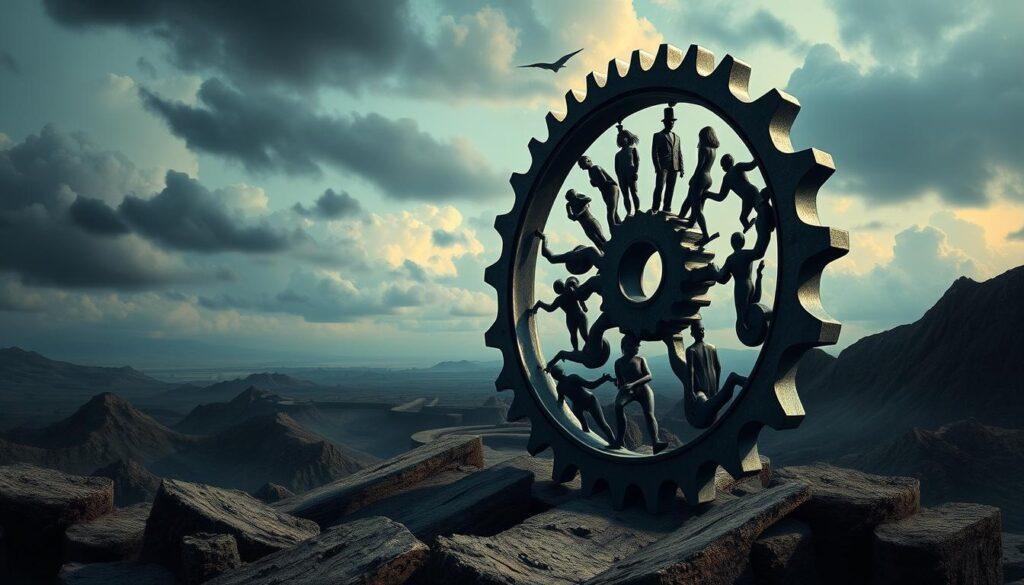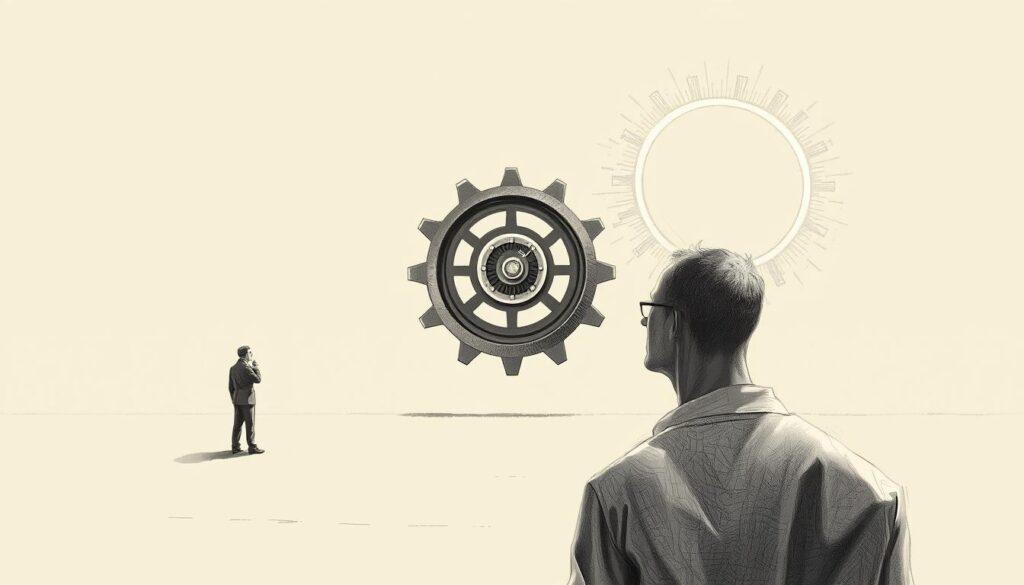Have you ever wondered why governments grow during crises but don’t shrink back? The ratchet effect mental model explains this phenomenon. It’s like a ratchet tool that tightens but can’t loosen.
First explored in 1961 by economists Alan Peacock and Jack Wiseman, it reveals why public spending increased after 9/11 and the 2008 crash.
Today, policies like the USA PATRIOT Act’s “sneak and peek” searches remain in effect. This mental model, connected to cognitive biases and behavioral economics, influences many areas. It affects your workplace goals and AI regulations.
Why do temporary fixes become permanent? Let’s explore how this hidden force shapes our choices and society.
Key Takeaways
- First defined in 1961 to explain why crisis-driven policies stick.
- Impacts everything from government budgets to personal finance decisions.
- Linked to cognitive biases like loss aversion and status quo bias.
- Seen in tech (AI rules) and climate policies, mirroring Parrondo’s paradox in game theory.
- Key to understanding why 2022 U.S. government spending hit 36% of GDP—up from 13.4% in 1950.
Understanding the Ratchet Effect Mental Model
Imagine a ratchet screwdriver: once turned forward, it never slips backward. The ratchet effect mental model works the same way, shaping how systems evolve—or fail to reverse.
This concept explains why changes like increased spending or policies often stick around, even when needed. Let’s unpack its origins and how it differs from similar ideas.
Definition and Core Concept
The ratchet effect describes irreversible advancements. For example, governments rarely cut budgets to pre-crisis levels after emergencies spending. This one-way trajectory influences everything from personal finances to global policies.
Its “mechanical” nature makes it a key decision-making model for predicting systemic behavior.
Origin of the Term “Ratchet Effect”
The term emerged from economic studies like Alan Peacock and Jack Wiseman’s 1961 report on public spending.
They noted how crises push budgets upward, but cuts are politically and psychologically harder. Later, Robert Higgs expanded this to show how temporary wartime measures often become permanent fixtures in governments.
How It Differs from Other Mental Models
| Mental Model | Key Feature | Example |
|---|---|---|
| Ratchet Effect | Irreversible progress | Post-crisis spending that stays elevated |
| Status Quo Bias | Resisting change | Employees rejecting pay cuts after raises |
| Sunk Cost Fallacy | Sticking to failing projects | Continuing a money-losing business |
Unlike the sunk cost fallacy’s emotional attachment to past investments, the ratchet effect focuses on institutional and psychological resistance to regression.
Its psychology ties to how humans anchor to new baselines, making it distinct from path dependency or loss aversion.
The Psychology Behind the Ratchet Effect
Cognitive psychology shows how the ratchet effect works in our minds. Achieving a goal makes us want more, thanks to irrational behaviors.
This cycle is based on how our brain sees progress, not just logic.

Think about perfectionism. Studies say we often see our achievements as “easy” or “insufficient.” This creates a ratchet-like effect. Cognitive psychology sees this as a survival tactic—our brain focuses on growth over happiness.
But this can lead to a never-ending cycle of wanting more.
| Factor | Ratchet Effect Impact |
|---|---|
| Loss Aversion | Fear of losinging gains locks you into irreversible choices. |
| Neuroplasticity | Brain adapts to higher standards, making retreat feel impossible. |
| Social comparison | Seeing others’ achievements triggers “one-way” striving for status. |
Angela Duckworth’s research on grit shows how persistence can be a problem. You might keep doing exhausting habits because they “worked before.”
This fits with irrational behaviors like increasing commitments to past decisions, even if they’re not good for you now.
Self-determination theory suggests that intrinsic motivation can fight this. But when loss aversion takes over, your mind sees setbacks as threats, not lessons.
Understanding these patterns is the first step to stopping the cycle of never-ending escalation.
How the Ratchet Effect Influences Your Decision-Making
Every choice you make shapes your future options. The ratchet effect makes you stick to familiar paths, even if they’re not the best. It’s important to understand how it affects decision-making.
Three main factors drive this effect: escalation of commitments, the pull of the status quo, and loss aversion.
Escalation of Commitments
Imagine a project that’s over budget but keeps getting funded. This is cognitive biases at work. Managers often stick with failing strategies to avoid admitting mistakes.
A study showed employees work less when incentives don’t match their efforts. This is a clear example of how biases can distort outcomes.
Status Quo Bias Connection
The status quo bias makes change seem riskier than staying the same. This mindset keeps organizations stuck in old systems. Research by Adolfo Sachsida found people avoid discomfort, even when better options exist.
Like a ratchet’s motion, these habits make you choose suboptimal options. This applies to work policies and personal goals.
The Role of Loss Aversion
Loss aversion makes you focus more on avoiding losses than gaining. In legal disputes, this bias leads plaintiffs to reject fair settlements for a chance at bigger payouts. Studies show 60% would’ve been better off settling.
Behavioral economists like Dan Ariely show how arbitrary anchors, like social security numbers, affect valuations. Recognizing these patterns is the first step to breaking their grip.
Real-World Examples of the Ratchet Effect Mental Model
Seeing the ratchet effect in action helps us understand why change is hard. It affects everything from business meetings to your bank account.
In Business and Organizations
Car makers like GM add features like GPS or leather seats every year. But taking them away is hard. Companies like GM sign long-term deals, losing flexibility.
Studies show 95% of suppliers make contracts to avoid being rejected. But this can lead to problems later. Companies like Hewlett Packard use short-term contracts to avoid these issues.
But, even with smart strategies, profit swings from these contracts can be a big problem.
In Personal Finance
Subscriptions, like cable or streaming services, keep adding up. Adding premium tiers feels like a gain, but cutting back feels like a loss. This is how behavioral economics works.
Most people keep services they don’t use, fearing they’ll regret cutting back. Upgrading your lifestyle, like getting a new car or house, also creates financial ratchets. Downsizing feels like a failure.
In Government Policy
Temporary pandemic aid programs often become permanent. After 9/11, security measures grew without end. Governments rarely remove policies once they’re in place.
This shows how the ratchet effect pushes for permanence, even when crises pass.
In Technology Development
Software updates always add new features, never remove old ones. Microsoft Office and smartphone cameras keep getting better every year. This is the ratchet effect in tech.
Apple’s iPhone, for example, can’t remove Face ID, even though it costs money. This shows how innovation paths become fixed by what users expect.
Benefits of Recognizing the Ratchet Effect in Your Life
Understanding the ratchet effect helps you change decision-making patterns that hold you back. By using cognitive psychology, you can see how cognitive biases affect your choices.
This lets you make intentional changes before they become big problems.

Studies show big benefits: programs for social-emotional skills improve grades by 0.57 effect size (Durlak et al., 2011).
Early education investments also pay off, returning $7–$10 for every dollar spent (Belfield & Levin, 2015). Clearly, recognizing the ratchet effect can change outcomes for the better.
| Area | Impact | Study Reference |
|---|---|---|
| Academic Performance | 25% reduction in problem behaviors | Jones et al., 2011 |
| Financial Health | Up to 20% higher earnings with early intervention | Chetty et al., 2011 |
| Behavioral Outcomes | 25% drop in substance use post-intervention | Spoth et al., 2008 |
By using these insights, you can create systems that fight against automatic escalation. This means setting budgets for long-term goals over short-term comforts, or managing workloads before they overwhelm you.
The ratchet effect is more than just a theory—it’s a guide for lasting progress in life.
Common Pitfalls and How to Avoid Them
Understanding the Ratchet Effect can help you break free from patterns that hold you back. These patterns come from irrational behaviors and bias in decision-making. Awareness is key to overcoming them.
Let’s look at three major issues and how to solve them:
Becoming Locked in Inefficient Systems
Teams often fall into irrational behaviors by copying others’ features without thinking. This “feature creep” wastes resources and ignores what users really need.
For example, adding tools that aren’t used increases complexity and policy inertia, just like environmental policy struggles. To avoid this, regularly check your systems and focus on what really matters, not just what others do.
Resistance to Positive Change
Even good changes can face resistance due to bias in decision-making. Studies show that those with less power are more open to compromise.
Yet, many stick to old ways. Understanding psychology behind this resistance is key. Use methods like “premortems” to think about what could go wrong and redefine goals.
Overcommitment to Previous Decisions
Psychology makes us invest too much in failing projects because of sunk cost fallacy. For example, businesses keep old software because of past spending, ignoring opportunity costs. Use frameworks like the AD-AS model to assess trade-offs.
Ask yourself: Does this choice match my current goals?
| Pitfall | Root Cause | Action |
|---|---|---|
| Feature Bloat | Competitor mimicry | Conduct quarterly reviews |
| Status quo attachment | Cognitive dissonance | Encourage “premortem” exercises |
| Sunk cost entanglement | Emotional attachment | Use decision trees to weigh trade-offs |
By using these strategies, you can turn systemic traps into chances for growth. Addressing these irrational behaviors head-on will help you stay adaptable in both work and personal life.
Practical Techniques to Apply or Counter the Ratchet Effect
Understanding the ratchet effect is key. By using behavioral economics, we can improve our decision-making models. This helps us avoid getting stuck in bad systems.
A study on schools showed that 661 K-5 schools stuck to old ways, showing the dangers of not changing.
Let’s look at ways to stay flexible.
Regular System Audits
Check your workflows and commitments often. Ask if they’re working as they should. Schools that checked themselves more often did better in tests, a study found.
Use checklists to find where we might be making bad choices.
Set Explicit Reversal Conditions
Make sure you can change your mind. For example, say “if test scores drop 10 points, we’ll change our curriculum.”
This approach helped 36% of K-8 schools stay adaptable. It’s based on behavioral economics, which shows setting exit points makes changing easier.
Create Flexibility in Planning
Make your systems easy to change. The Collingridge dilemma1 shows that schools with fixed K-5 plans did worse in 5th-grade tests than those with K-8 plans. Use pilot programs and planning to avoid making permanent mistakes.
Choose iterative prototyping over all-or-nothing decisions.
Conclusion
Learning about the ratchet effect mental model changes how you make decisions and understand psychology’s role.
It shows how temporary actions can become permanent in policies, finances, and habits. This can trap you in systems that no longer meet your goals.
The PATRIOT Act’s lasting impact and pandemic restrictions are examples. They show how crises can give governments more power or change the economy long after they’re over.
Knowing the psychology behind the ratchet effect helps you avoid its traps. Policies like post-9/11 surveillance or pandemic lockdowns show how temporary steps can become lasting rules.
But, this knowledge also lets you check your own decisions and keep options open.
Start by looking at one area of your life where the ratchet effect might be at play. Ask yourself: “Does this choice match my current values?” The First Step Act’s changes show that even big systems can change with effort.
By using this mental model in your decision-making, you’ll see chances to adapt. And you’ll avoid trends that could shape your future in ways you don’t want.


